A New Method for Shale Oil Injecting-Stewing-Producing Physical Modeling Experiments Based on Nuclear Magnetic Resonance
Abstract
1. Introduction
2. Experiment Apparatus and Materials
2.1. Experimental Material
2.2. Experimental Equipment and Parameters
2.3. Pre-Experimental Preparation
- (1)
- Core Cutting and Oil Washing: Meticulous sample preparation is essential for precise NMR analysis of shale, with steps like sample preparation, oil washing, drying, and saturation critically influencing the outcomes of shale tests. To this end, the shale samples were meticulously prepared using diamond wire cutters. They were drilled in anhydrous conditions, maintaining a diameter of approximately 2.5 cm, to avert any alteration of the original pore structure, which could be caused by hydration reactions between the shale and water. Pictures of the cores before and after treatment are shown in Figure 3.
- (2)
- Crude Oil Saturation in the Core: Given the inherent base permeability of the shale and the relatively high viscosity of crude oil, it becomes imperative to implement vacuum and high-pressure saturation procedures for the core. A schematic representation of the saturation apparatus is depicted in Figure 4, with the detailed procedural steps outlined as follows:
- ①
- The core is first subjected to oil washing, then placed in an oven where it is baked at 100 °C for 48 h. This process is aimed at drying the core, after which it is weighed. Subsequently, the core’s porosity and permeability are rigorously tested.
- ②
- The core is then placed into a core container and subjected to a continuous vacuum process using a vacuum pump for 24 h, ensuring thorough evacuation of air from the core.
- ③
- Valves V3 and V4 are opened, and the piston is pressurized via the injection pump, facilitating the movement of crude oil into the core container.
- ④
- Once the crude oil in the core container fully immerses the core, the pressure within the container is maintained at 30 MPa. After a saturation period of 120 h, the pressure gradually decreased. The core is then allowed to stand for an additional 24 h, following which it is removed and weighed.
- (3)
- Signal Calibration of Fluids for Nuclear Magnetic Experiments
2.4. Experimental Methods and Procedures
- Initially, place the core, which has been saturated with crude oil via vacuum and high-pressure processes (ensuring the saturation level is greater than 60%), into the core gripper. Then, scan the T2 spectrum using low-field NMR to determine the initial state.
- Two intermediate vessels are prepared, one filled with imbibition solution (deuterium oxide solution containing 0.2% surfactant) and the other filled with CO2. The CO2 was pumped into the intermediate container by a pressure pump and pressurized to more than 15 MPa.
- Employ a constant pressure and speed pump to infuse the permeate solution into the clamp at a steady flow rate of 0.01 mL/min until the pressure reaches 15 MPa, thereby simulating fracturing conditions. Record the injection duration and total volume of permeate solution injected throughout this process.
- Activate the intermediate container containing CO2 pressurized at 15 MPa. Utilize a constant pressure and speed pump to methodically inject liquid CO2 into the core gripper at a steady flow rate of 0.01 mL/min, elevating the pressure to 25 MPa. Throughout this procedure, meticulously record the duration of the injection and the total volume of CO2 injected. Upon ceasing the injection, conduct a subsequent NMR scan to assess the changes.
- Seal the core holder and maintain the well under a system pressure of 25 MPa for 48 h, simulating a simmering process. Subsequently, conduct another NMR scan.
- Upon completion of the simmering phase, open the outlet for extraction, maintaining a 2 MPa differential pressure using a pressure return valve. As the system’s differential pressure decreases to 23, 21, 19, 17, and 15 MPa, scan one set of NMR signals at each pressure level, resulting in five sets of NMR signals. Ensure continuous production for 4 h at each pressure.
- Repeat the aforementioned experimental procedures for the second and third experimental cycles.
- Thoroughly process the accumulated NMR data and determine the extent of crude oil extraction from the core by calculating the magnitude of the NMR signals for each experimental operation.
3. Discussion of Experimental Results
3.1. The First Cycle of Experiments on Injecting-Stewing-Producing
3.2. Second Cycle of Experiments on Injecting-Stewing-Producing
3.3. Third Cycle of Experiments on Injecting-Stewing-Producing
3.4. Discussion of Experimental Results
4. Conclusions
- (1)
- This study validates the practicality of the Injecting-Stewing-Producing integrated experimental approach formulated by the author for the shale reservoir Huff-n-Puff. The experiments facilitate an in-depth investigation into the microscale transport of crude oil across various pore sizes throughout different Huff-n-Puff cycles. In the production phase following the simmering of the well, the behavior of crude oil within various pore sizes exhibits distinct variations under different production pressures. Specifically, crude oil residing in pores smaller than 200 nanometers tends to preferentially migrate to larger pore spaces before being extracted. This pattern suggests a dynamic redistribution of oil within the reservoir, where smaller pores act as initial sources and larger pores serve as subsequent pathways for oil extraction. Conversely, crude oil within larger pores (greater than 200 nm) is initially prioritized for extraction. In the latter stages of production, pores smaller than 200 nm predominantly contribute to the extracted crude oil.
- (2)
- The findings enable optimization of Huff-n-Puff cycles and injection timing in the oil recovery process. The extraction rates for the first and second Huff-n-Puff cycles are 29.55% and 10.56%, respectively, while the third cycle achieves only a 6.57% rate. Furthermore, as Huff-n-Puff cycles increase, a marked decline in replacement efficiency is observed, plummeting from 46% in the initial cycle to 9.4% in the final cycle. Therefore, in practical mining scenarios, it is advisable to conduct two Huff-n-Puff cycles to balance recovery rates against investment costs. Moreover, when production pressure drops to 60% of the original formation pressure, it becomes imperative to introduce imbibition fluid and CO2 to replenish formation energy and enhance recovery efficiency.
Author Contributions
Funding
Data Availability Statement
Conflicts of Interest
References
- Lei, Q.; Xu, Y.; Cai, B.; Guan, B.; Wang, X.; Bi, G.; Li, H.; Li, S.; Ding, B.; Fu, H.; et al. Progress and Prospects of Horizontal Well Fracturing Technology for Shale Oil and Gas Reservoirs. Pet. Explor. Dev. 2022, 49, 166–172. [Google Scholar] [CrossRef]
- Lei, Q.; Weng, D.; Xiong, S.; Liu, H.; Guan, B.; Deng, Q.; Yan, X.; Liang, H.; Ma, Z. Progress and Development Directions of Shale Oil Reservoir Stimulation Technology of China National Petroleum Corporation. Pet. Explor. Dev. 2021, 48, 1035–1042. [Google Scholar] [CrossRef]
- Zou, C.; Li, J.; Yang, S.; He, D.; Wei, Y.; Jia, A.; Chen, J.; Zhao, Q.; Li, Y.; Li, J.; et al. Theory, Technology, and Prospects of Conventional and Unconventional Natural Gas. Pet. Explor. Dev. 2018, 45, 13. [Google Scholar] [CrossRef]
- Jin, Z.; Wang, G.; Liu, G.; Gao, B.; Liu, Q.; Wang, H.; Liang, X.; Wang, R. Research progress and key scientific issues of continental shale oil in China. Acta Pet. Sin. 2021, 42, 821–835. [Google Scholar] [CrossRef]
- Ma, Y.; Cai, X.; Zhao, P.; Hu, Z.; Liu, H.; Gao, B. Geological characteristics and exploration practices of continental shale oil in China. Acta Geol. Sin. 2022, 96, 155–171. [Google Scholar] [CrossRef]
- Zan, L.; Luo, W.; Yin, Y.; Jing, X. Formation conditions of shale oil and favorable targets in the second member of Paleogene Funing Formation in Qintong Sag, Subei Basin. Pet. Geol. Exp. 2021, 43, 233–241. [Google Scholar] [CrossRef]
- Zhu, X.; Duan, H.; Sun, Y. Breakthrough and significance of Paleogene continental shale oil exploration in Gaoyou sag, Subei Basin. Acta Pet. Sin. 2023, 44, 1206–1221, 1257. [Google Scholar] [CrossRef]
- Zhang, L.; Li, J.; Li, Z.; Zhang, J.; Zhu, R.; Bao, Y. Advances in Shale Oil/Gas Research in North America and Considerations on Exploration for Continental Shale Oil/Gas in China. Adv. Earth Sci. 2014, 29, 700–711. [Google Scholar] [CrossRef]
- Song, G.; Zhang, L.; Lei, S.; Xu, X.; Shu, R.; Wang, M.; Li, Z. Resource evaluation method for shale oil and its application. Earth Sci. Front. 2013, 20, 221–228. [Google Scholar]
- Zhang, L.; Li, J.; Li, Z.; Zhu, R.; Zhang, S.; Liu, Q.; Zhang, J.; Chen, Z. Characteristics and Genesis Mechanism of Organic Storage Space Development in Lacustrine Shale. Earth Sci. (J. China Univ. Geosci.) 2015, 40, 1824–1833. [Google Scholar]
- Liu, Y.; Chen, Z.; Ji, D.; Peng, Y.; Hou, Y.; Lei, Z. Pore Fluid Movability in Fractured Shale Oil Reservoir Based on Nuclear Magnetic Resonance. Processes 2023, 11, 3365. [Google Scholar] [CrossRef]
- Fan, R.; Liao, G.; Mao, R.; Luo, X.; Hou, L.; Zhang, H.; Tian, H.; Wang, G.; Qin, Z.; Xiao, L. Nuclear magnetic resonance response characteristics and quantitative evaluation method of fluid saturation of lacustrine shale oil. Front. Earth Sci. Sec. Solid Earth Geophys. 2023, 11, 1117193. [Google Scholar] [CrossRef]
- Gu, M.; Xie, R.; Guo, J.; Jin, G. Evaluation of Fluid Saturation in Shale Using 2D Nuclear Magnetic Resonance. Energy Fuels 2023, 37, 2713–2720. [Google Scholar] [CrossRef]
- Li, J.; Wang, M.; Fei, J.; Xu, L.; Shao, H.; Li, M.; Tian, W.; Lu, S. Determination of in situ hydrocarbon contents in shale oil plays. Part 2: Two-dimensional nuclear magnetic resonance (2D NMR) as a potential approach to characterize preserved cores. Mar. Pet. Geol. 2022, 145, 105890. [Google Scholar] [CrossRef]
- Zhang, P.; Lu, S.; Li, J.; Chang, X. 1D and 2D Nuclear magnetic resonance (NMR) relaxation behaviors of protons in clay, kerogen and oil-bearing shale rocks. Mar. Pet. Geol. 2020, 114, 104210. [Google Scholar] [CrossRef]
- Xu, F.; Jiang, H.; Liu, M.; Jiang, S.; Wang, Y.; Li, J. NMR-Based Analysis of Fluid Occurrence Space and Imbibition Oil Recovery in Gulong Shale. Processes 2023, 11, 1678. [Google Scholar] [CrossRef]
- Huang, X.; Li, X.; Zhang, Y.; Li, T.; Zhang, R. Microscopic Production Characteristics of Crude Oil in Nano-Pores of Shale Oil Reservoirs During CO2 Huff and Puff. Pet. Explor. Dev. 2022, 49, 636–643. [Google Scholar] [CrossRef]
- Yu, H.; Xu, H.; Fu, W.; Lu, X.; Chen, Z.; Qi, S.; Wang, Y.; Yang, W.; Lu, J. Extraction of shale oil with supercritical CO2: Effects of number of fractures and injection pressure. Fuel 2021, 285, 118977. [Google Scholar] [CrossRef]
- Yu, W.; Lashgari, H.R.; Wu, K.; Sepehrnoori, K. CO2 injection for enhanced oil recovery in Bakken tight oil reservoirs. Fuel 2015, 159, 354–363. [Google Scholar] [CrossRef]
- Al-Yaseri, A.Z.; Lebedev, M.; Vogt, S.J.; Johns, M.L.; Barifcani, A.; Iglauer, S. Pore-scale analysis of formation damage in Bentheimer sandstone with in-situ NMR and micro-computed tomography experiments. J. Pet. Sci. Eng. 2015, 129, 48–57. [Google Scholar] [CrossRef]
- Yang, F.; Ning, Z.F.; Wang, Q.; Zhang, R.; Krooss, B.M. Pore structure characteristics of lower Silurian shales in the southern Sichuan Basin, China: Insights to pore development and gas storage mechanism. Int. J. Coal Geol. 2016, 156, 12–24. [Google Scholar] [CrossRef]
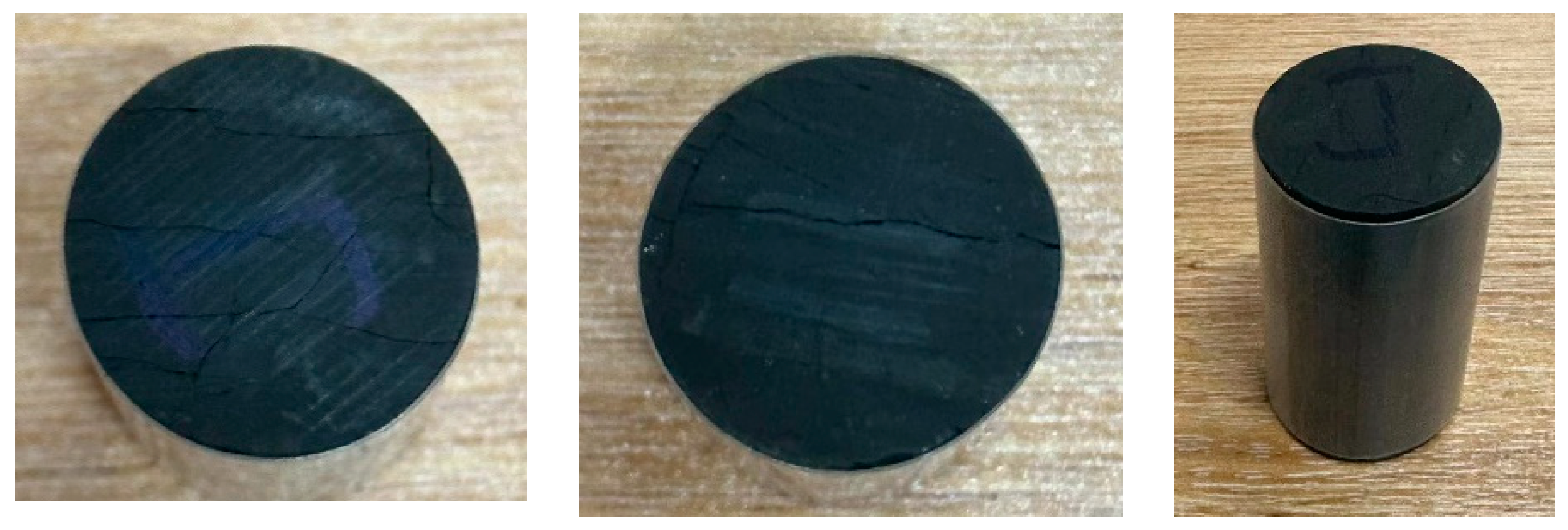
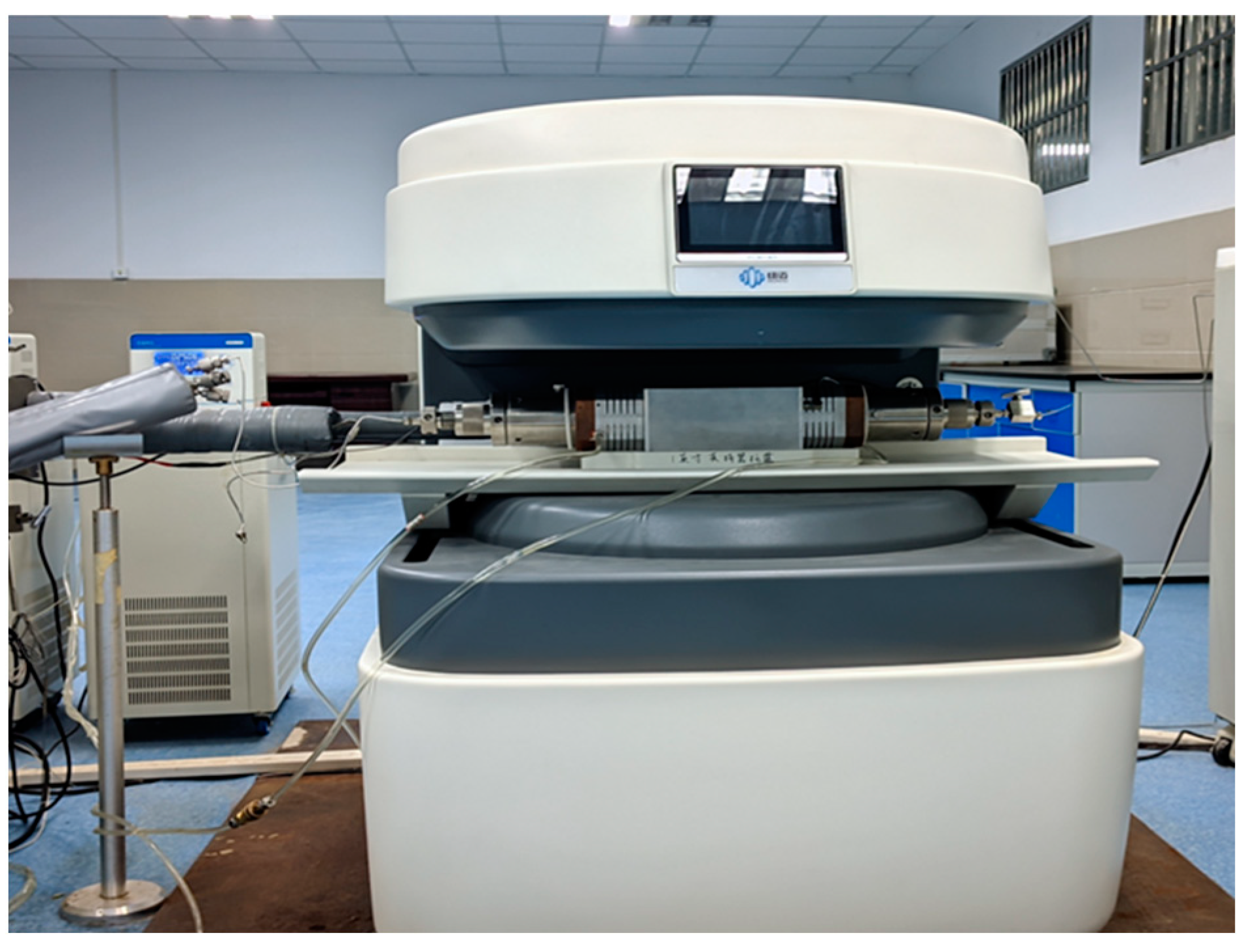



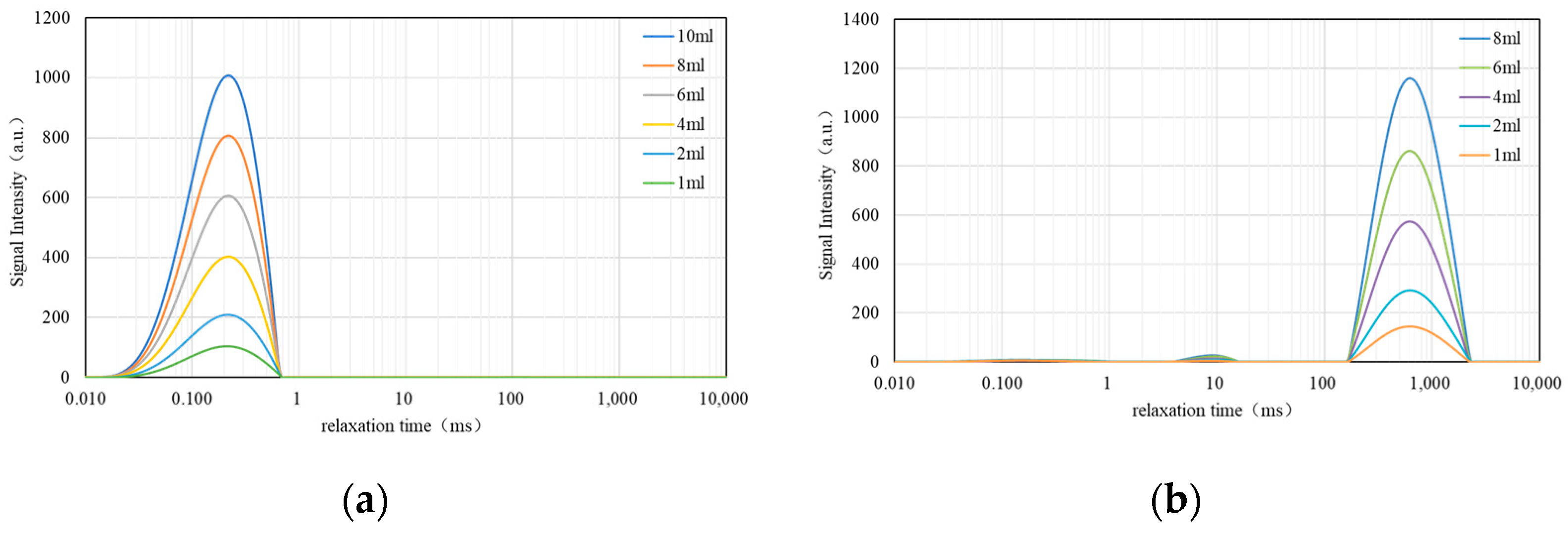
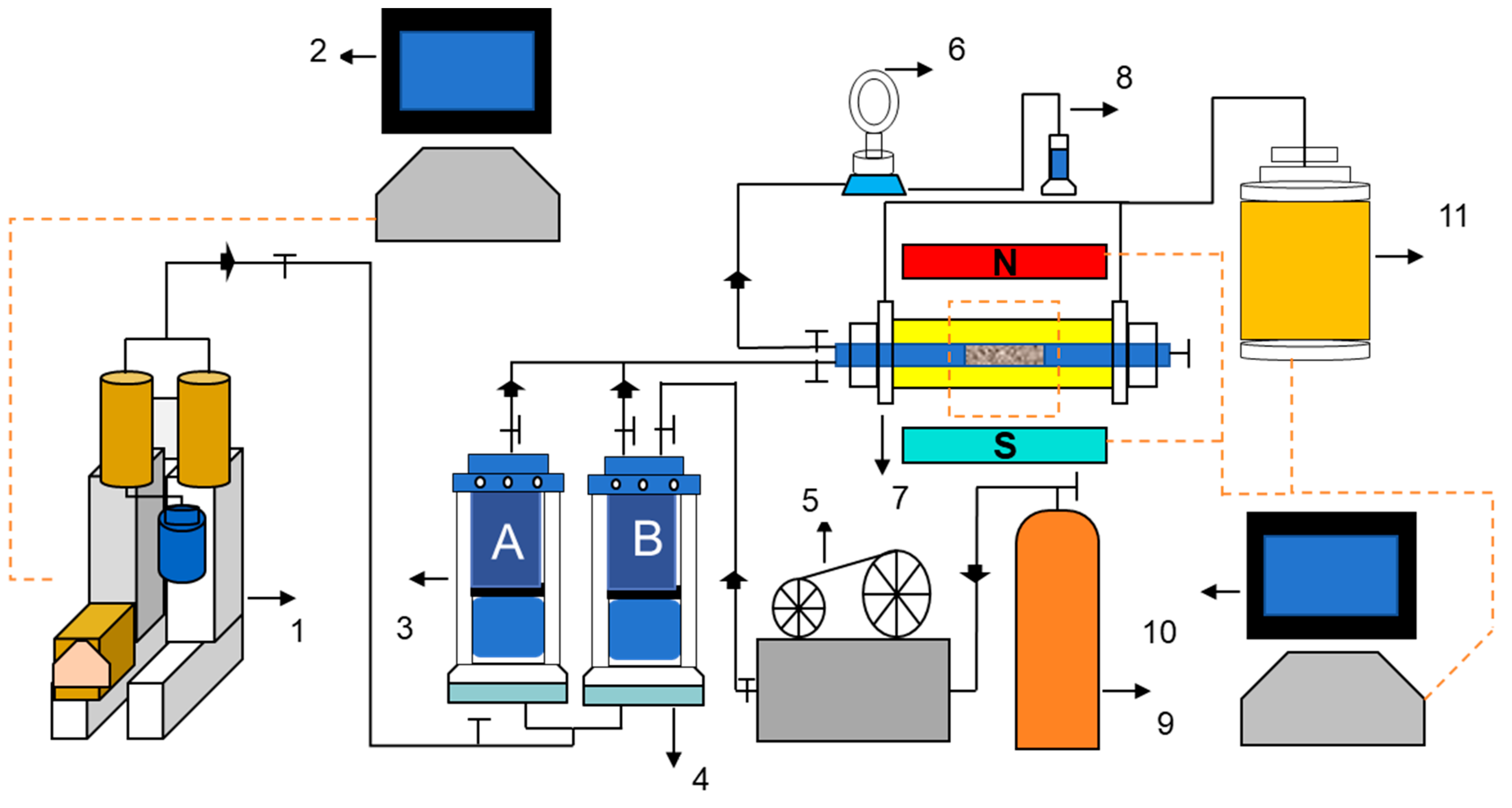




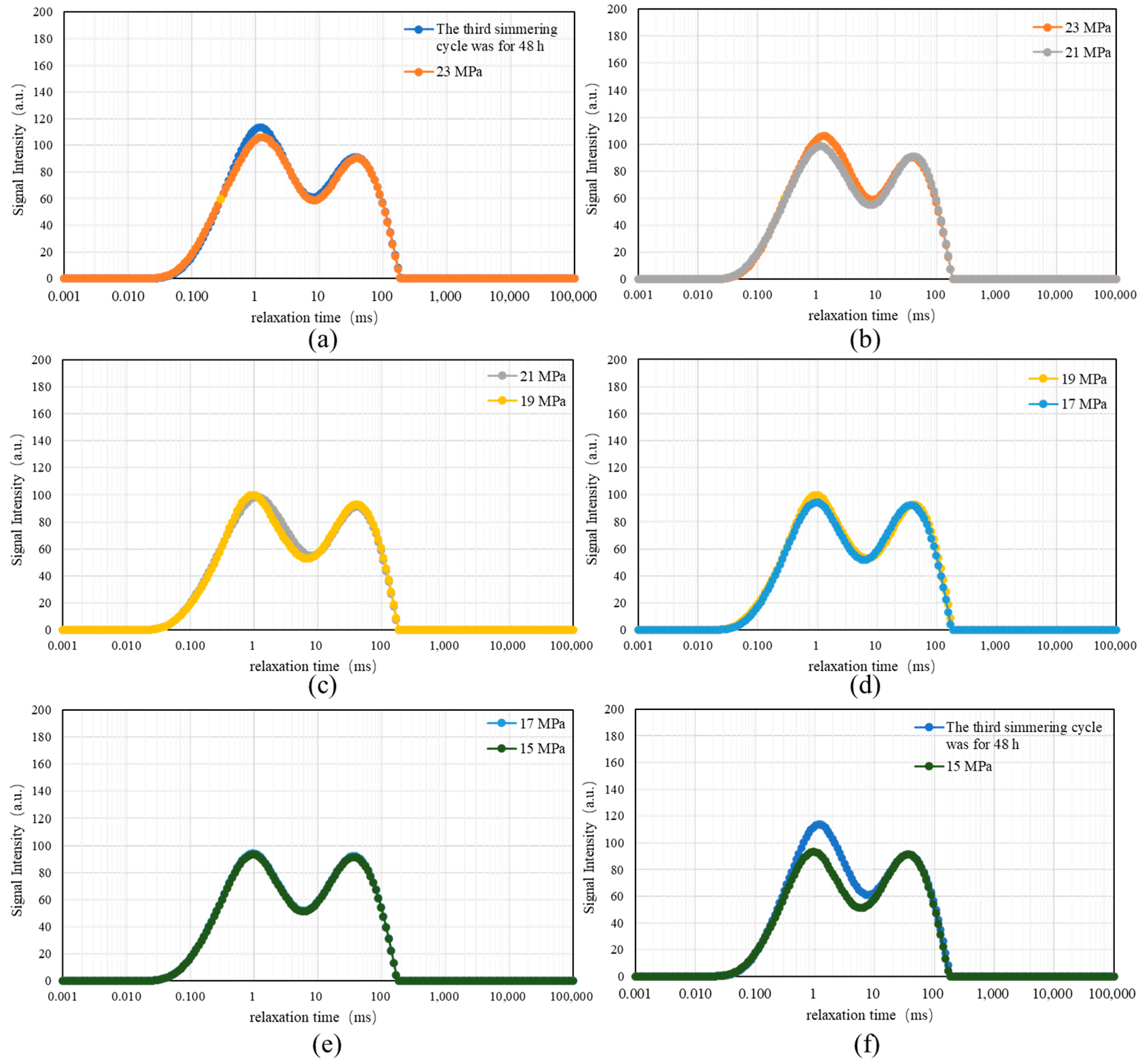

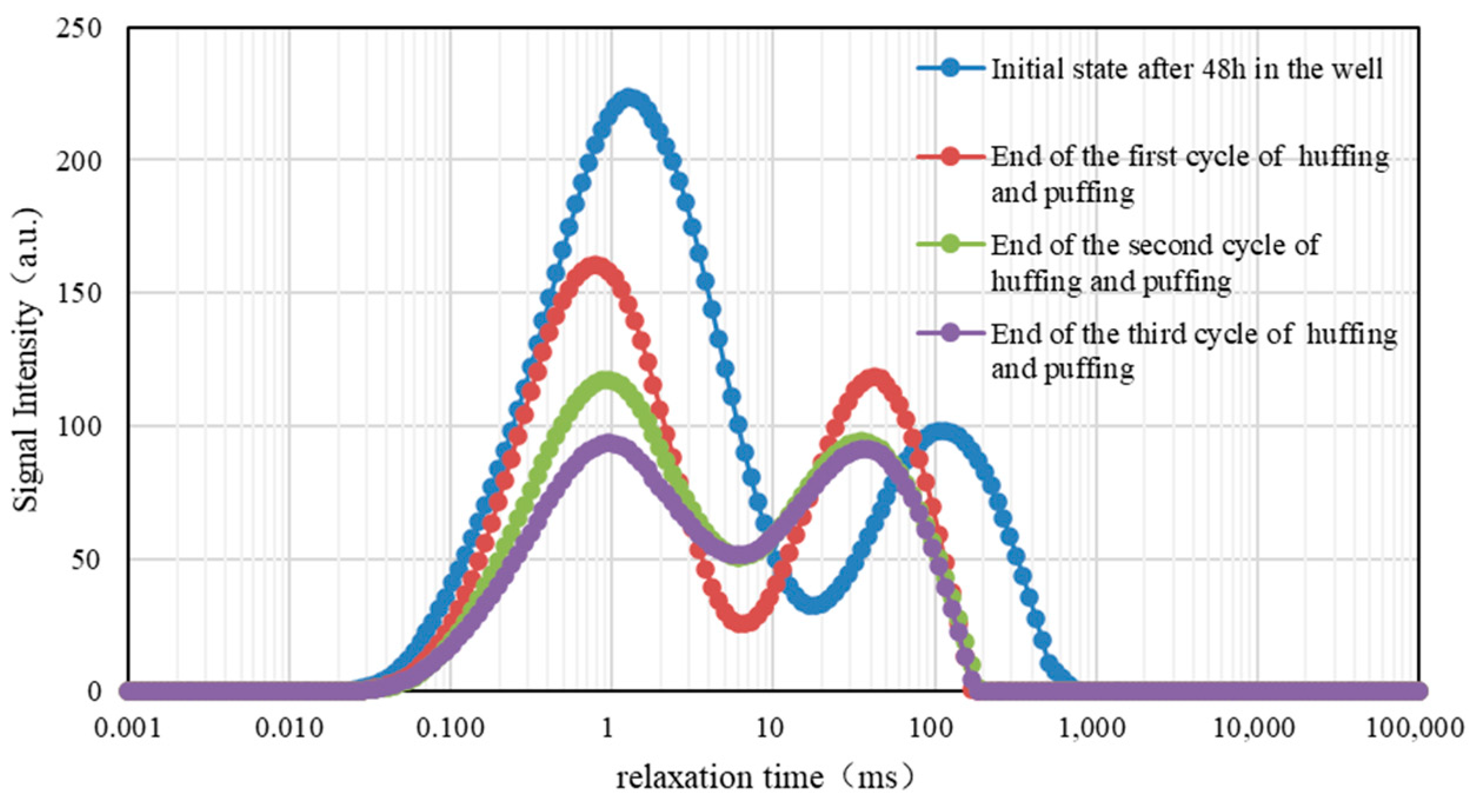

| Diameter, mm | Length, mm | Rock Core Volume, cm3 | Porosity, % | Pore Volume, cm3 | Permeability, 10−3 μm2 |
|---|---|---|---|---|---|
| 25.01 | 46.67 | 23.05 | 4.51 | 1.04 | 1.81 |
| Symbol Name and Unit | Meaning and Description |
|---|---|
| SF (MHz) | Primary value of RF signal frequency |
| O1 (KHz) | RF signal frequency offset |
| P1 (us) | RF 90° pulse width |
| P2 (us) | RF 180° pulse width |
| SW (KHz) | The frequency range of the signal received by the receiver and the sampling frequency of the signal during sampling |
| RFD (ms) | RF delay |
| TW (ms) | Repeat Sampling Interval |
| RG1 | Analog Gain |
| DRG1 | Digital Gain |
| PRG | Preamplification Gain |
| NS | Accumulated sampling times |
| TE (ms) | Echo time |
| NECH | Number of echoes |
| Production Process | Total Signal (a.u.) | Volume of Oil Recovered (mL) | Extraction Level (%) | Remaining Oil Volume (mL) |
|---|---|---|---|---|
| Stewed well for 48 h | 10,010.81 | 0.000 | 0.000 | 0.713 |
| 23 MPa | 8694.71 | 0.094 | 13.147 | 0.619 |
| 21 MPa | 8203.88 | 0.129 | 18.050 | 0.584 |
| 19 MPa | 7531.37 | 0.177 | 24.767 | 0.536 |
| 17 MPa | 7129.20 | 0.205 | 28.785 | 0.508 |
| 15 MPa | 7052.96 | 0.211 | 29.546 | 0.502 |
| Production Process | Total Signal (a.u.) | Volume of Oil Recovered (mL) | Extraction Level (%) | Remaining Oil Volume (mL) |
|---|---|---|---|---|
| Stewed the well for 48 h after the 2nd Huff-n-Puff | 7050.39 | 0.2109 | — | 0.502 |
| 23 MPa | 6771.34 | 0.2307 | 32.360 | 0.482 |
| 21 MPa | 6476.08 | 0.2518 | 35.309 | 0.461 |
| 19 MPa | 6274.54 | 0.2661 | 37.322 | 0.447 |
| 17 MPa | 6051.96 | 0.2820 | 39.546 | 0.431 |
| 15 MPa | 5995.36 | 0.2860 | 40.111 | 0.427 |
| Production Process | Total Signal (a.u.) | Volume of Oil Recovered (mL) | Extraction Level (%) | Remaining Oil Volume (mL) |
|---|---|---|---|---|
| Stewed the well for 48 h after the 3rd Huff-n-Puff | 5994.46 | 0.2861 | — | 0.427 |
| 23 MPa | 5845.23 | 0.2967 | 41.611 | 0.416 |
| 21 MPa | 5635.67 | 0.3116 | 43.704 | 0.401 |
| 19 MPa | 5575.35 | 0.3159 | 44.307 | 0.397 |
| 17 MPa | 5391.22 | 0.3291 | 46.146 | 0.384 |
| 15 MPa | 5337.31 | 0.3329 | 46.684 | 0.380 |
| Huff-n-Puff Cycles | Volume of Imbibition Fluid (mL) | Volume of CO2 (mL) | Stage Oil Production (mL) | Stage Extraction Level (%) | Replacement Efficiency (%) |
|---|---|---|---|---|---|
| First cycle | 0.18 | 0.28 | 0.211 | 29.55 | 46 |
| Second cycle | 0.22 | 0.25 | 0.075 | 10.56 | 16 |
| Third cycle | 0.23 | 0.27 | 0.047 | 6.57 | 9.4 |
Disclaimer/Publisher’s Note: The statements, opinions and data contained in all publications are solely those of the individual author(s) and contributor(s) and not of MDPI and/or the editor(s). MDPI and/or the editor(s) disclaim responsibility for any injury to people or property resulting from any ideas, methods, instructions or products referred to in the content. |
© 2024 by the authors. Licensee MDPI, Basel, Switzerland. This article is an open access article distributed under the terms and conditions of the Creative Commons Attribution (CC BY) license (https://creativecommons.org/licenses/by/4.0/).
Share and Cite
Li, S.; Sun, J.; Liu, D.; Zhao, X. A New Method for Shale Oil Injecting-Stewing-Producing Physical Modeling Experiments Based on Nuclear Magnetic Resonance. Energies 2024, 17, 694. https://doi.org/10.3390/en17030694
Li S, Sun J, Liu D, Zhao X. A New Method for Shale Oil Injecting-Stewing-Producing Physical Modeling Experiments Based on Nuclear Magnetic Resonance. Energies. 2024; 17(3):694. https://doi.org/10.3390/en17030694
Chicago/Turabian StyleLi, Sichen, Jing Sun, Dehua Liu, and Xuankang Zhao. 2024. "A New Method for Shale Oil Injecting-Stewing-Producing Physical Modeling Experiments Based on Nuclear Magnetic Resonance" Energies 17, no. 3: 694. https://doi.org/10.3390/en17030694
APA StyleLi, S., Sun, J., Liu, D., & Zhao, X. (2024). A New Method for Shale Oil Injecting-Stewing-Producing Physical Modeling Experiments Based on Nuclear Magnetic Resonance. Energies, 17(3), 694. https://doi.org/10.3390/en17030694





